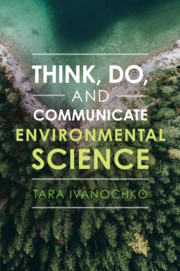Book contents
- Think, Do, and Communicate Environmental Science
- Think, Do, and Communicate Environmental Science
- Copyright page
- Contents
- Prologue
- Acknowledgements
- Introduction
- Part I Thinking Environmental Science
- Part II Doing Environmental Science
- Chapter 5
- Chapter 6
- Chapter 7
- Chapter 8
- Chapter 9
- Chapter 10
- Chapter 11
- Chapter 12
- Part III Communicating Environmental Science
- Epilogue
- Appendix: Working in Excel
- Glossary
- Index
- References
Chapter 10
from Part II - Doing Environmental Science
Published online by Cambridge University Press: 23 April 2021
- Think, Do, and Communicate Environmental Science
- Think, Do, and Communicate Environmental Science
- Copyright page
- Contents
- Prologue
- Acknowledgements
- Introduction
- Part I Thinking Environmental Science
- Part II Doing Environmental Science
- Chapter 5
- Chapter 6
- Chapter 7
- Chapter 8
- Chapter 9
- Chapter 10
- Chapter 11
- Chapter 12
- Part III Communicating Environmental Science
- Epilogue
- Appendix: Working in Excel
- Glossary
- Index
- References
Summary
Environmental data is more than a bunch of numbers. Meaningful information about the natural world is embedded in those numbers as patterns, cycles, trends, changes, and events. Arranging your data in different ways can highlight different features of the phenomena captured by your data set. This dual aspect of a data set is its power: data is quantifiable information. You can describe the key features of your data set using words, but you can also quantify, or characterize, critical information using numbers, mathematical equations, or statistical concepts.
- Type
- Chapter
- Information
- Think, Do, and Communicate Environmental Science , pp. 133 - 152Publisher: Cambridge University PressPrint publication year: 2021

